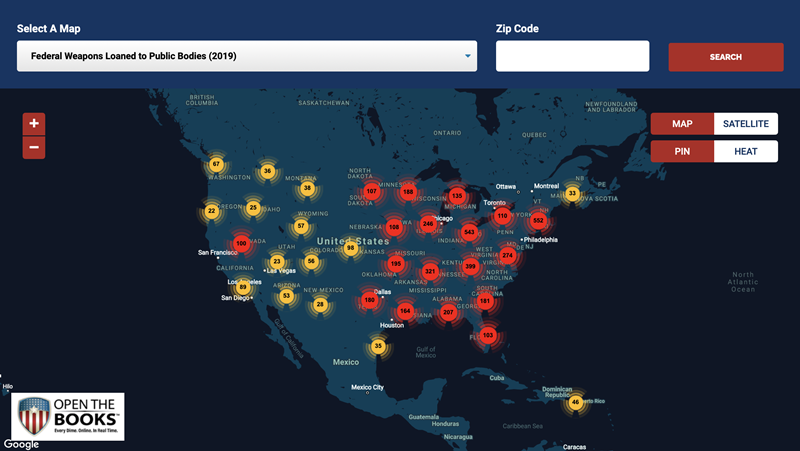



By Adam Andrzejewski
With his lone rifle rack, America’s sheriff, Andy Griffith, once stood as our iconic image of local law enforcement.
Now, even in rural towns, your local police department's armory may look more like a Marine Corps weapons depot than anything in Mayberry.
Local law enforcement agencies have since 1993 received billions of dollars’ worth of military equipment including mine resistant vehicles, armored trucks, helicopters, M16’s and M14’s, infrared goggles, grenade launchers, and airplanes. The gear transfers are part of the Pentagon authorization known as Program 1033.
Surprisingly, California’s police departments– a state with some of the strictest gun laws – procured the most military weaponry from the Pentagon.
California ($153.1 million) edged out Texas ($144 million), Tennessee ($133.7 million), Florida ($105.6 million), Arizona ($93.9 million), Alabama ($88.7 million), and South Carolina ($76.3 million) in the receipt of military surplus equipment.
Now, you can search our interactive map by ZIP Code and see which law enforcement agencies received what types of equipment – both in quantity and acquisition value. Just click a pin (ZIP Code) and scroll down to review the results rendered in the chart beneath the map.
Just how much equipment from the Pentagon flowed to your local police department? Quite likely, your own hometown police received some gear.

This summer, civil unrest in urban areas has sparked renewed interest in the transfer of surplus military equipment to local law enforcement agencies, and people of good faith on both the left and right are raising serious concerns regarding civil liberties and the militarization of local police departments.
What is the legitimate law enforcement purpose for local police departments to acquire war weapons? Does the militarization of local police threaten our civil liberties?
So, this week, we released our OpenTheBooks oversight reportanalyzing Program 1033. We found 600,000 items worth $1.8 billion distributed to 8,200 local police agencies. (All items were in current inventory at local law enforcement agencies as of March 2020.)
Even thinly populated counties in California procured mine resistant vehicles. For example, Amador County (pop. 38,000) in the Sierra Nevada mountains received two ($1.3 million value).
In Texas, the Cypress Fairbanks Independent School District police received 60 bayonets-knives ($4,236 value) and Granite Sholas police procured ten more. Please explain the policing purpose of a bayonet – in a school district? Our request for comment was ignored.
In Wyoming, the Campbell County sheriff’s Office (pop. 46,341) received $1.5 million in gear including two mine-resistant vehicles, an armored truck, and 17 M14 rifles.
In 2016, citizen outrage helped shut down a local police department in Illinois after our oversight reporting at Forbesrevealed that the police in London Mills (pop. 381) acquired $201,445 in military equipment including rifles, generators, trucks, and Humvees.
Here are the top takeaways from our report on Program 1033:
Total items – 581,034 items of surplus military gear worth $1.8 billion flowed to state and local police agencies since 1993 – an amount that only includes the items still held in inventory by law enforcement agencies.
Top law enforcement agency –The Department of Law Enforcement of Tallahassee, Florida, procured the most gear ($20.6 million), an amount that exceeded the sum total of the bottom seven states. Items included fixed wing aircraft ($17 million), multi-mode imaging systems ($2.5 million), and a utility system modular tent ($229,062).
Heavy equipment – Transfers included mine resistant vehicles (1,099 items, $743.8 million value); trucks (cargo, panel, van, dump, utility, lift, and military) (3,465 items, $251 million value); helicopters (344 items, $83.6 million value); airplanes (24 items, $104.8 million value); and armored trucks and cars (284 items, $24.4 million value).
Weaponry – Transfers included rifles, M16 (5.62mm) and M14 (7.62mm) (66,375 items, $26.2 million value); .38, .40, and .45 caliber pistols (7,339 items, $689,553 value); 12-guage riot shotguns (1,218 items, $121,611 value); bayonets (167 items, $11690 value); and grenade launchers (seven items, $27,814 value).
Other military gear – Transfers included night-vision sights, sniper scopes, binoculars, telescopes, and goggles (131,358 items, $42 million value); mine detecting sets, marking kits, and probes (230 items, $599,341 million value).
Military robots – Transfers included remote controlled vehicles, underwater vehicles, explosive ordinance disposal, and stun devices (451 items, $20.4 million value).
Most expensive items – The California Highway Patrol received a $22 million fixed wing aircraft in 2016. The Arizona Department of Public Safety received $51 million in fixed wing aircraft (3) delivered on December 3, 2015 with each plane valued at $17 million.
Least expensive item – Two wood screws (23 cents) were transferred to the Weatherly Police Department in Pennsylvania on June 5, 2019.
Only state not participating – Hawaii was the only state not in the federal data receiving Program 1033 surplus military equipment.
The federal Defense Logistics Agency (DLA) provides the database of disclosed military gear transferred to the states. However, from previous reporting, weapons, ammunition, and military equipment also transferred to other federal agencies. This year, DLA did not provide that information.
We reached out to the DLA for comment and did not hear back.